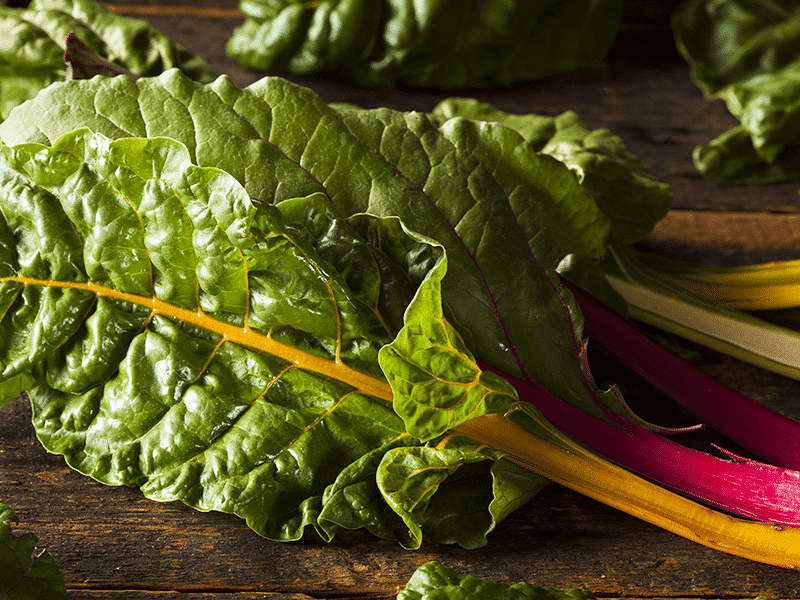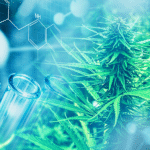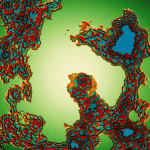Project CBD recently reported on studies indicating that cannabis terpenes — the compounds that give the plant its robust and distinctive smell — activate the CB1 cannabinoid receptor. What’s more, in the presence of THC (also a CB1 agonist), terpenes appear to modulate cannabinoid activity in varied and interesting ways.1,2 Today we focus on spicy-peppery beta-caryophyllene (BCP), one of the most common cannabis terpenes, which acts on several targets that impact the endocannabinoid system, not just CB1.
BCP is also a component of black pepper, basil, oregano, cinnamon, hops, rosemary, cloves, and citrus, as well as many leafy greens. Approved by the United States Food and Drug Administration for use as a flavoring and fragrance agent in food, this powerhouse sesquiterpene has been the subject of considerable medical-science research. Recent papers explore the potential role of BCP in treating a wide range of conditions including non-alcoholic fatty liver disease, chronic pain, and substance abuse.
A “Dietary Cannabinoid”
Beta-caryophyllene, a weak CB1 agonist, is what scientists refer to as a “full agonist” at the CB2 cannabinoid receptor, which plays an important role in regulation of immune function and inflammation. Its presence in many foods and spices and its strong affinity for CB2 has earned BCP recognition as the first known “dietary cannabinoid.”
Multiple studies have shown that beta-caryophyllene also interacts with peroxisome proliferator-activated receptors (PPARs, pronounced pee-parrs) located on the surface of the cell’s nucleus. CBD also activates these receptors, which regulate metabolism and energy homeostasis.
Given the role of PPARs and the endocannabinoid system in modulating metabolic processes, a group of researchers based in Turin, Italy, wanted to see if BCP was effective in a cellular model of non-alcoholic fatty liver disease, the most common chronic liver disorder worldwide with a global prevalence of more than 30%.3
Writing in the International Journal of Molecular Sciences in March 2023,4 the researchers note that not only did they observe improvements in diseased liver cells, but they also confirmed through the use of specific receptor antagonists that these changes were indeed mediated by CB2 and two PPAR receptor types: PPAR-alpha and PPAR-gamma.
(Interestingly, multiple large epidemiological studies5 — including one published in May 2023 in the journal PLoS One6 — have linked cannabis use with reduced risk of fatty liver disease. This new evidence out of Italy suggests that activation of CB2 and PPAR receptors may be at least partly responsible.)
Alzheimer’s & Substance Abuse
Other studies in recent years have added to our understanding of beta-caryophyllene’s myriad potential health benefits and multiple methods of action. In 2014, for example, Chinese researchers at Chongqing Medical University reported that BCP prevented cognitive impairment in a mouse model of Alzheimer’s. This positive cognitive outcome “was associated with reduced beta-amyloid burden in both the hippocampus and the cerebral cortex,” according to their paper in the journal Pharmacology,7 which identified CB2 receptor activation and the PPAR-gamma pathway as mediators of BCP’s neuroprotective effects.
More recently, a July 2022 paper in BioFactors8 by Iranian scientists reviewed the antioxidant and immunomodulatory effects of beta-caryophyllene, which was shown to reduce relevant proinflammatory cytokines while increasing anti-inflammatory cytokines. CB2 and PPAR-gamma, among other cellular pathways, were cited as key mechanisms of action.
And a December 2022 article in Current Neuropharmacology,9 by researchers in Brazil, investigated BCP’s potential “as a new drug for the treatment of substance use disorders.” The authors reviewed previous preclinical studies using animal models of addiction to cocaine, nicotine, alcohol, and methamphetamine. “Remarkably,” they concluded, the terpene “prevented or reversed behavioral changes resulting from drug exposure,” with evidence again pointing to the involvement of both CB2 and PPAR-gamma.
Painkiller
Finally, a paper by scientists with an Indian company called Vidya Herbs, which produces a black-pepper-seed extract called Viphyllin, suggests that beta-caryophyllene can reduce pain in mice primarily via activation of CB2, PPAR-alpha, and a third pathway also shared with cannabidiol: the TRPV1 (pronounced trip-vee-one) ion channel.
Published in the Journal of Pain Research10 in February 2022, the study involved administration of both 90% pure beta-caryophyllene and the black-pepper extract Viphyllin, which contains at least 30% beta-caryophyllene alongside lesser quantities of limonene, beta-pinene, and sabinene (three terpenes that can also be found in various cannabis strains).
When Viphyllin was given at about three times the dose of pure BCP, the two treatments proved to be similarly effective at reducing pain in all four behavioral models employed.
In three of these tests, the researchers also used blockers of CB1, CB2, TRPV1, and PPAR-alpha to evaluate how Viphyllin worked on the molecular level. They found that CB2, PPAR-alpha, and TRPV1 were most responsible for conveying the black pepper extract’s analgesic effect, but that the common terpene target CB1 may have played a role, as well.
Nate Seltenrich, Project CBD contributing writer, is the author of the column Bridging the Gap. An independent science journalist based in the San Francisco Bay Area, he covers a wide range of subjects, including environmental health, neuroscience, and pharmacology. © Copyright, Project CBD. May not be reprinted without permission.
Footnotes
- Raz, Noa et al. “Selected cannabis terpenes synergize with THC to produce increased CB1 receptor activation.” Biochemical pharmacology vol. 212 (2023): 115548. doi:10.1016/j.bcp.2023.115548
- LaVigne, Justin E et al. “Cannabis sativa terpenes are cannabimimetic and selectively enhance cannabinoid activity.” Scientific reports vol. 11,1 8232. 15 Apr. 2021, doi:10.1038/s41598-021-87740-8
- Younossi, Zobair M et al. “The global epidemiology of nonalcoholic fatty liver disease (NAFLD) and nonalcoholic steatohepatitis (NASH): a systematic review.” Hepatology (Baltimore, Md.) vol. 77,4 (2023): 1335-1347. doi:10.1097/HEP.0000000000000004
- Scandiffio, Rosaria et al. “Beta-Caryophyllene Modifies Intracellular Lipid Composition in a Cell Model of Hepatic Steatosis by Acting through CB2 and PPAR Receptors.” International journal of molecular sciences vol. 24,7 6060. 23 Mar. 2023, doi:10.3390/ijms24076060
- Kim, Donghee et al. “Inverse association of marijuana use with nonalcoholic fatty liver disease among adults in the United States.” PloS one vol. 12,10 e0186702. 19 Oct. 2017, doi:10.1371/journal.pone.0186702
- Du, Rui et al. “Marijuana use is inversely associated with liver steatosis detected by transient elastography in the general United States population in NHANES 2017-2018: A cross-sectional study.” PloS one vol. 18,5 e0284859. 18 May. 2023, doi:10.1371/journal.pone.0284859
- Cheng, Yujie et al. “β-Caryophyllene ameliorates the Alzheimer-like phenotype in APP/PS1 Mice through CB2 receptor activation and the PPARγ pathway.” Pharmacology vol. 94,1-2 (2014): 1-12. doi:10.1159/000362689
- Baradaran Rahimi, Vafa, and Vahid Reza Askari. “A mechanistic review on immunomodulatory effects of selective type two cannabinoid receptor β-caryophyllene.” BioFactors (Oxford, England) vol. 48,4 (2022): 857-882. doi:10.1002/biof.1869
- Asth, Laila et al. “Effects of β -caryophyllene, A Dietary Cannabinoid, in Animal Models of Drug Addiction.” Current neuropharmacology vol. 21,2 (2023): 213-218. doi:10.2174/1570159X20666220927115811
- Venkatakrishna, Karempudi et al. “ViphyllinTM, a Standardized Black Pepper Seed Extract Exerts Antinociceptive Effects in Murine Pain Models via Activation of Cannabinoid Receptor CB2, Peroxisome Proliferator-Activated Receptor-Alpha and TRPV1 Ion Channels.” Journal of pain research vol. 15 355-366. 5 Feb. 2022, doi:10.2147/JPR.S351513
Recommended Readings
I’m Just Mad About Saffron
The benefits of common kitchen spices are mediated by cannabinoid receptors in the brain.
Caryophyllene Reduces Alcohol Consumption
Caryophyllene and its derivative caryophyllene oxide are significant terpenoids found in many green leafy vegetables.
ICRS 2018: CBD Shines in Leiden (Part 1)
New scientific findings highlight the 28th annual meeting of the International Cannabinoid Research Society.










